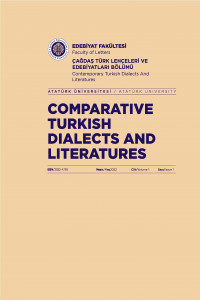EDEBÎ METİNLERDE BULUNAN KURAL DIŞI KOMBİNASYONLARIN LİNGVOPOETİK ÖZELLİKLERİ
Makalenin girişinde edebi eser ve dil ilişkisi üzerinde durulmuştur. Edebi eseri normal bir metinden ayıran en önemli özelliği, dilinin sanatlı olmasıdır. Edebiyat, söz sanatıdır. Edebi eser de bütün metinler gibi sözcüklerden oluşur fakat edebi eseri oluşturan sözcükler, şair veya yazarın sanat ve estetik anlayışını yansıtacak şekilde bir araya getirilir ve edebi eser böylece diğer metinlerden ayrılır. Her bir edebi eser belli bir ölçüde yazıldığı “dil”in estetik düzeyini yansıtır. Edebi metnin anlam derinliği, sanat seviyesi ve estetik düzeyi, biraz da içinde geçen sıradışı anlam birlikleri ve kelime gruplarının sıklığına bağlıdır. Müellifin edebi metin içinde sıradışı anlam birlikleri ve kelime grupları kullanması, metni okuyucu için daha çekici hale getirir. Bu aynı zamanda okuyucunun tasavvur dairesini genişletir, ufkunu açar ve okuyucuyu aktif hale getirir. Çünkü müellif söylemek istediği şeyi herkesin kullandığı sözcükleri kullanarak açıkça söylememiş; alışılmadık ifadelerin arkasına gizlemiştir. Onu çözmek okuyucuya kalmıştır. Böyle bir eserin okuyucusunun zihni okuma eylemi boyunca sürekli çalışır halde olmak zorundadır. Makalenin devamında, 20. yüzyıl Özbek edebiyatı temsilcilerinden Said Ahmad, Tahir Malik ve Ötkir Haşimov’un eserlerinden sıradışı anlam birlikleri ve kelime grupları örnekleri verilmiş ve izah edilmiştir.
Anahtar Kelimeler:
dilbilim, dilbilimsel poetika, sanatsal metin, olağandışı kombinasyonlar, edebiyat
LİNGVOPOETİC CHARACTERİSTİCS OF UNUSUAL COMBİNATİONS FOUND İN LİTERARY TEXTS
In the introduction of the article, the relationship between lite-rary work and language is emphasized. The most important feature that distinguishes a literary work from a normal text is its artistic language. Literature is the art of speech. Literary work, like all texts, consists of words, but the words that make up the literary work are brought together to reflect the poet or author's understanding of art and aesthetics, and the literary work is thus separated from other texts. Each literary work, to a certain extent, reflects the aesthetic level of the "language" in which it was written. The depth of meaning, artistic level and aesthetic level of the literary text depend a little on the frequency of the unusual meaning as-sociations and word groups in it. The author's use of unusual semantic associations and word groups in the literary text makes the text more att-ractive to the reader. At the same time, it expands the imagination circle of the reader, opens his horizons and activates the reader. Because the author did not clearly say what he wanted to say by using the words everyone uses; hidden behind unconventional expressions. It is up to the reader to decipher it. The mind of the reader of such a work must be constantly working throughout the act of reading.In the continuation of the article, examples of unusual meaning associations and word groups from the works of Said Ahmad, Tahir Ma-lik and Ötkir Hashimov, who are representatives of 20th century Uzbek literature, are given and explained.
Keywords:
linguopoetics, linguistic poetics, artistic text, unusual combinations, literature,
___
- Ahmad, S. (2008). “Kiprikda qolgan tong”, Sharq NMAK. Toshkent.
- Hoshimov, O‘. (2019). “Dunyoning ishlari” / qissa / “Abadiy barhayot asarlar” turkumi. N. - T.: “Ilm-ziyo-zakovat”.
- Malik, T. (2007). “Shaytanat”. www.ziyouz.com.
- Yo‘ldoshev, M. (2009). Badiiy matnning lingvopoetik tadqiqi. Toshkent: Fan.
- Başlangıç: 2022
- Yayıncı: Atatürk Üniversitesi
Sayıdaki Diğer Makaleler
KIRGIZİSTAN’DA YAPILAN DEDE KORKUT ÇALIŞMALARI
Sedat ADIGÜZEL, Akmaral ŞEYŞENBEKOVA
KAYNAK ESERİN ÜSLUBUNUN ÇEVİRİ ESERE YANSITILMASI SORUNU
EDEBÎ METİNLERDE BULUNAN SIFATLARIN TERİM OLARAK KULLANIMI
EDEBÎ METİNLERDE BULUNAN KURAL DIŞI KOMBİNASYONLARIN LİNGVOPOETİK ÖZELLİKLERİ
